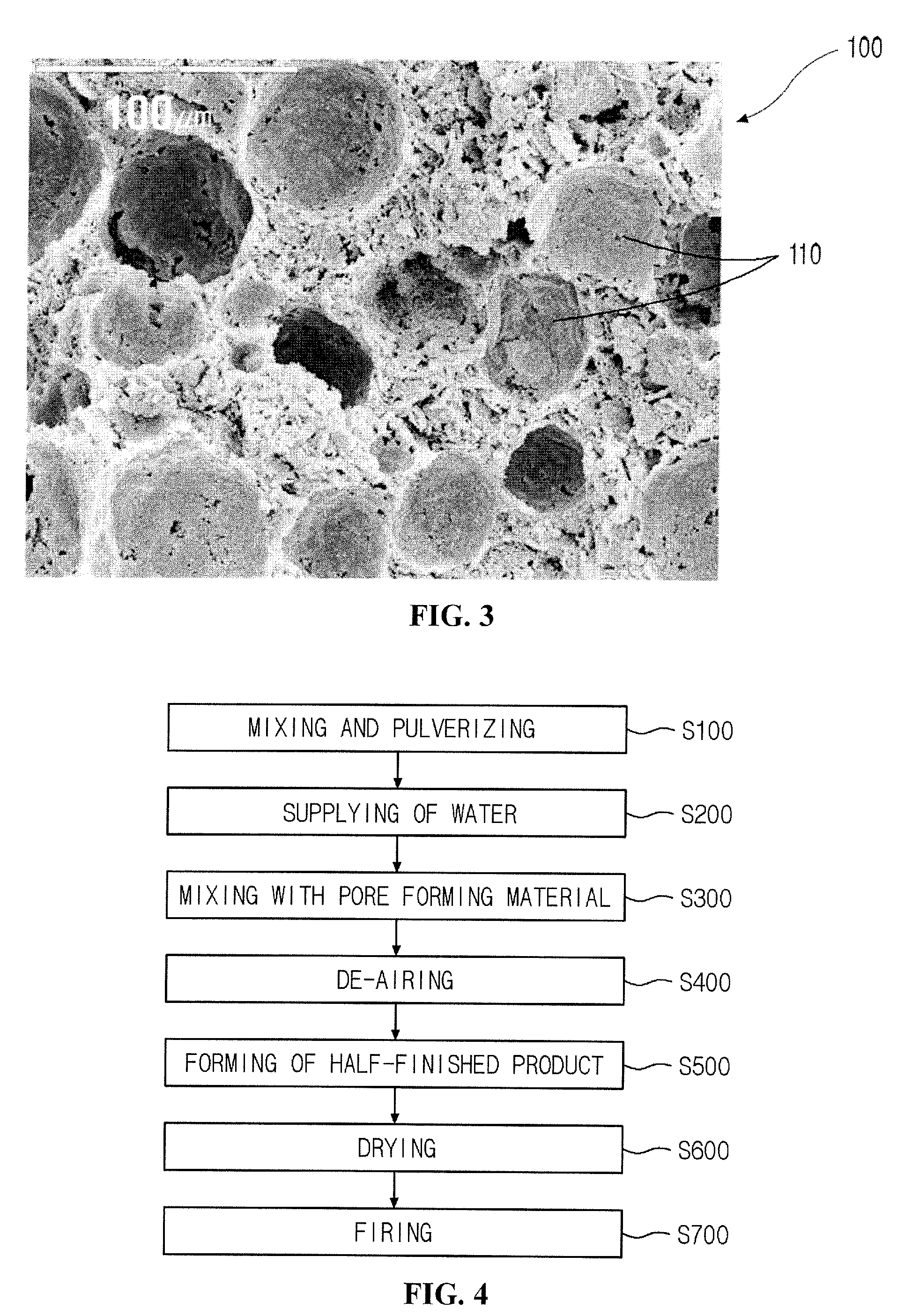Porous humidity-control tile and method for manufacturing the same
a humidity control and tile technology, applied in the field of porous humidity control tiles, can solve the problems of difficult humidity control, increased allergic diseases such as asthma and atopy, and malfunctioning of precise devices,
- Summary
- Abstract
- Description
- Claims
- Application Information
AI Technical Summary
Benefits of technology
Problems solved by technology
Method used
Image
Examples
example 1
[0063]In Example 1, the characteristics of a porous humidity-control tile were evaluated according to the amount of hollow microspheres (pore forming material) and the thickness of specimens.
[0064]Raw-material powder containing a mixture of diatomite and clay (weight ratio of diatomite and clay=1:1) as shown in Table 1 below was pulverized and mixed through a ball milling process and was then made into slurry. The amount of moisture of the slurry was adjusted by filter pressing.
[0065]At this time, about 10 vol % to about 50 vol % of a pore forming material was added to the raw-material powder containing diatomite and clay. The raw-material slurry containing the pore forming material was carried into a de-airing pug mill for remove air from the slurry (de-airing).
[0066]While the de-airing process was performed, the slurry was shaped into a half-finished product. In detail, the slurry from which air was removed was continuously extruded through a nozzle of the de-airing pug mill in a ...
example 2
[0072]In example 2, firing was performed for 3 hours while varying the firing temperature in the range from about 700° C. to about 1000° C. to observe the porous and humidity-control characteristics of a porous humidity-control tile.
[0073]As shown in Table 2, a mixture of red clay and kaolin was used as raw-material powder. The raw-material powder was pulverized and mixed through a ball milling process and was then made into slurry. The amount of moisture of the slurry might be adjusted by filter pressing.
[0074]At this time, about 50 vol % of hollow microspheres (pore forming material) were added to the raw-material powder. The raw-material slurry containing the pore forming material was carried into a de-airing pug mill for remove air from the slurry (de-airing).
[0075]While the de-airing process was performed, the slurry was shaped into a half-finished product. In detail, the slurry from which air was removed was continuously extruded through a nozzle of the de-airing pug mill. The...
example 3
[0078]In example 3, the humidity-control characteristics of porous humidity-control tile specimens were measured while varying the amount of diatomite contained in raw-material powder in the range from about 40% to about 70%.
[0079]Raw-material powder was pulverized and mixed through a ball milling process and was then made into slurry. The amount of moisture of the slurry was adjusted by filter pressing.
[0080]Here, mixtures having diatomite: clay ratios as shown in Table 3 were used as the raw-material powder. About 10 vol % of hollow microspheres (pore forming material) were added to the raw-material powder. The raw-material slurry containing the pore forming material was carried into a de-airing pug mill for remove air from the slurry (de-airing).
[0081]The slurry from which air was removed was continuously extruded through a nozzle of the de-airing pug mill in a tile scrap shape to obtain a half-finished product.
[0082]The half-finished product was dried in a dry chamber for removi...
PUM
| Property | Measurement | Unit |
|---|---|---|
| Temperature | aaaaa | aaaaa |
| Temperature | aaaaa | aaaaa |
| Fraction | aaaaa | aaaaa |
Abstract
Description
Claims
Application Information
 Login to View More
Login to View More - R&D
- Intellectual Property
- Life Sciences
- Materials
- Tech Scout
- Unparalleled Data Quality
- Higher Quality Content
- 60% Fewer Hallucinations
Browse by: Latest US Patents, China's latest patents, Technical Efficacy Thesaurus, Application Domain, Technology Topic, Popular Technical Reports.
© 2025 PatSnap. All rights reserved.Legal|Privacy policy|Modern Slavery Act Transparency Statement|Sitemap|About US| Contact US: help@patsnap.com



